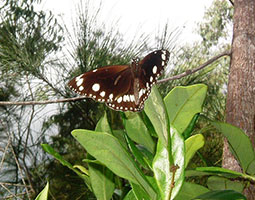Euploea core
Description

The Common Crow Butterfly, also known as the Oleander Butterfly, is a glossy-black, medium-sized 85-95 mm butterfly with rows of white spots on the margins of its wings. It reflects a dark blue colour under sunlight. Unlike many species of butterfly, male and female Common Crow butterflies are very similar in appearance, with only minor differences visible.
The female lays its eggs on the leaves of plants that have a milky sap, including various figs (Ficus spp.) and Parsonsia spp. When the caterpillars hatch, they begin to feed for approximately 21 days. The caterpillars (larvae) are orange-brown with a dark underside, with each segment striped black and white across the top. The sides of the caterpillar have a white band or series of white spots. They form a pupa which can be metallic silver or gold in colour, which lasts for a further two weeks. When the adult emerges, it only has a lifespan of 11 - 13 weeks.
Adaptations
- Have a strong odour that may discourage some predators from eating it
- Able to eat a wide variety of food plants
Feeding relationships
- What I eat: as a caterpillar - plants such as Oleander, Morton Bay Fig, Brazilian Jasmine and Frangipani; as a butterfly — nectar from various flowering plants, including eucalypts
- What eats me: spiders, dragonflies, birds and wasps
Interesting facts
The Common Crow Butterfly is one of the most widely distributed butterflies in Australia. Adult Common Crow butterflies overwinter together for protection in large aggregations of one to two thousand individuals. The Common Crow Butterfly produces toxins so strong that eating just one butterfly may induce many birds to vomit.